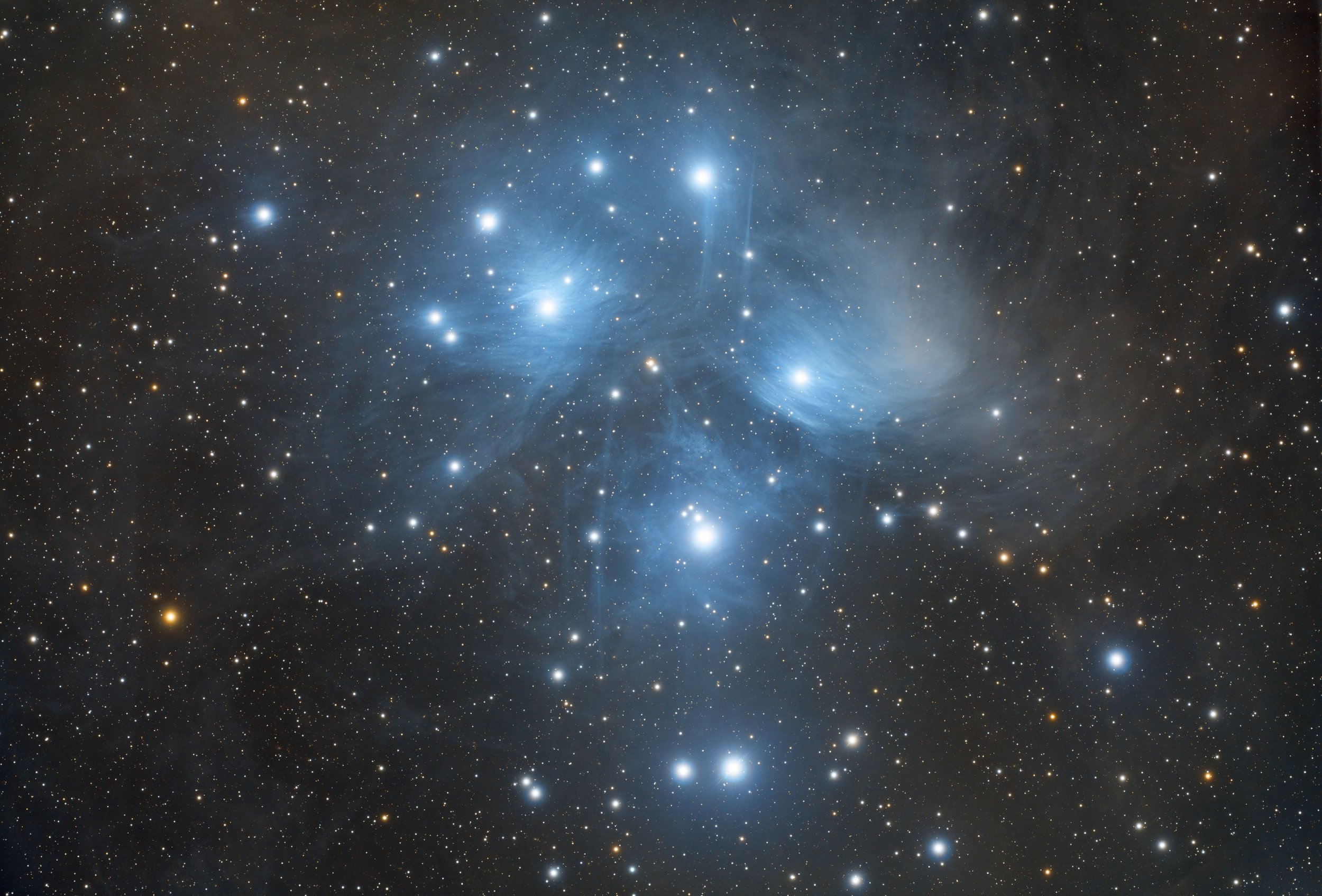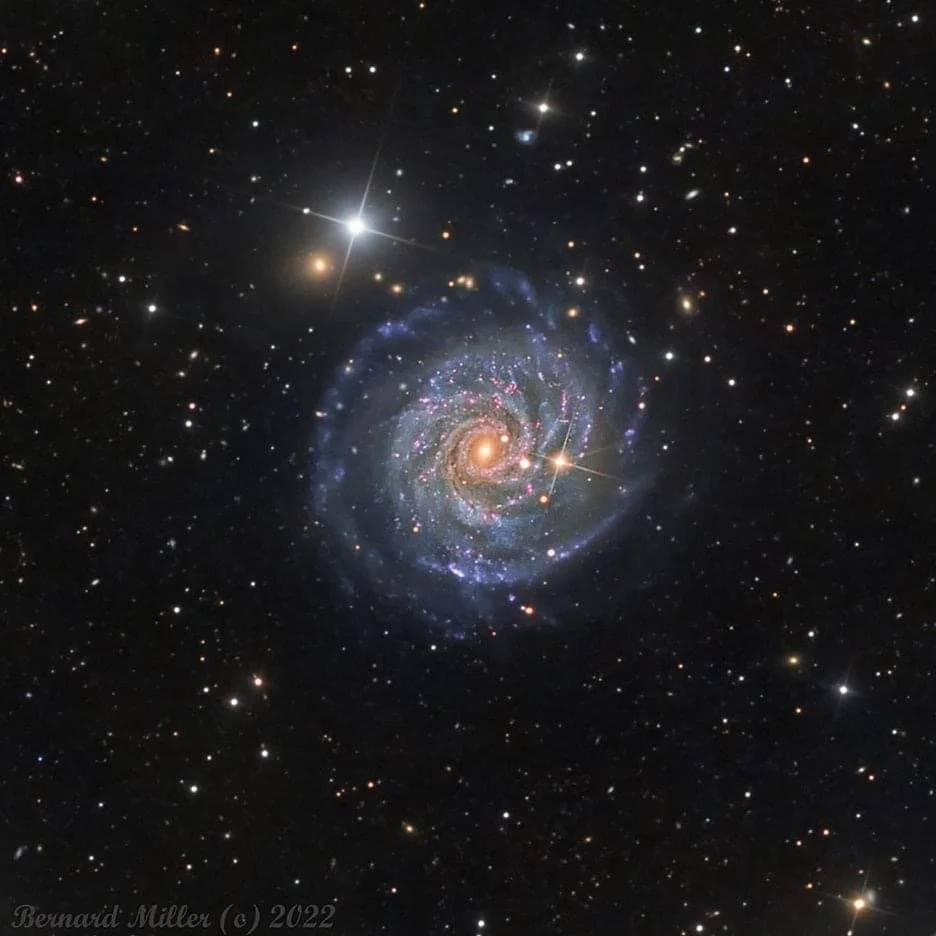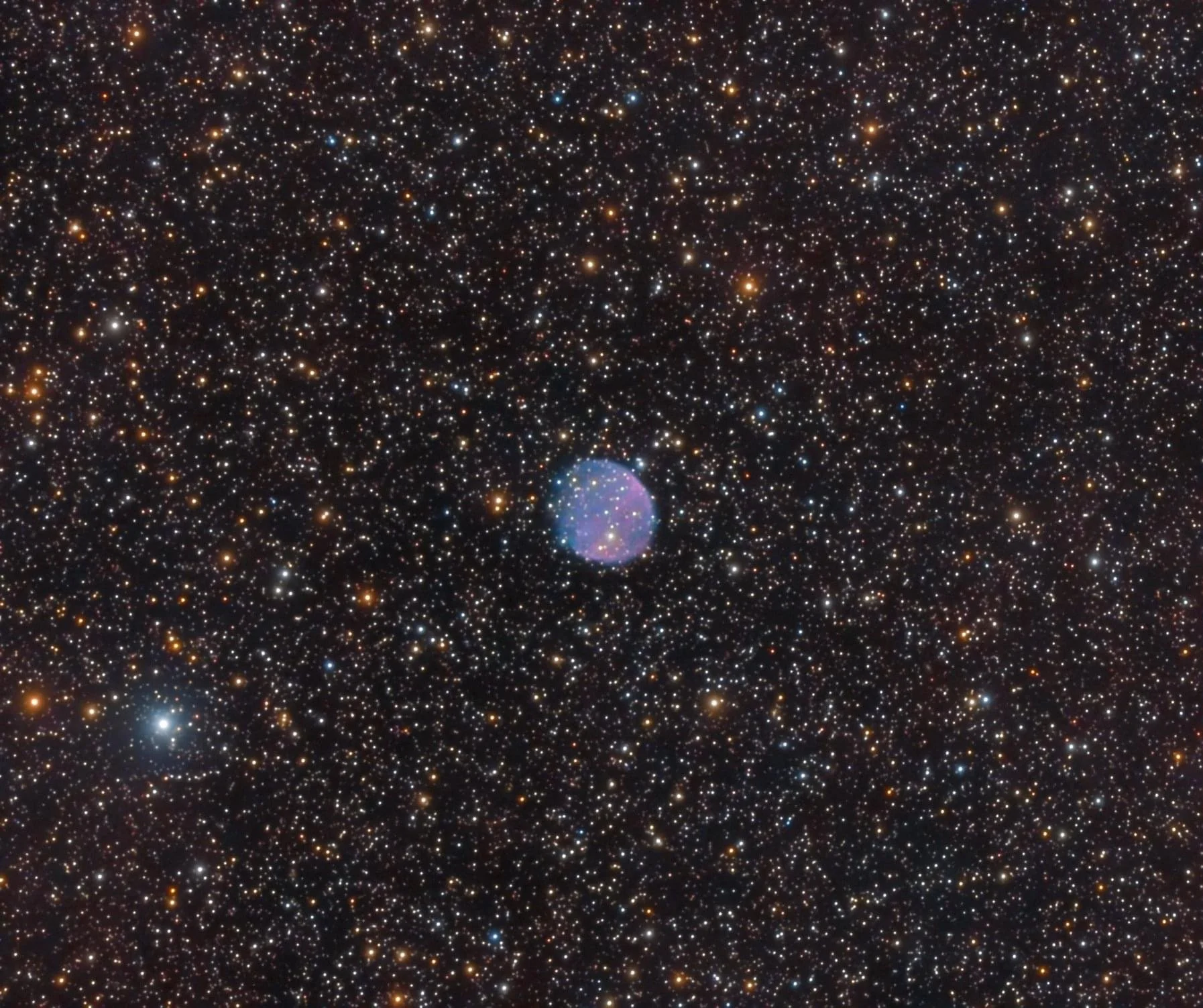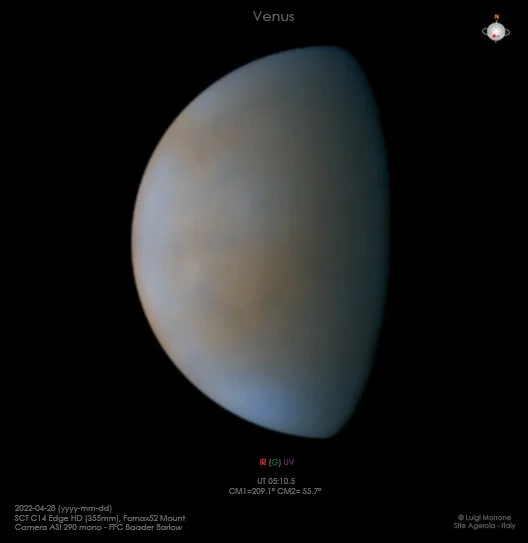
AAPOD2 Image Archives
NGC 3344
This is an image of NGC 3344. It is a barred spiral galaxy about 22.5 million light years away in the constellation Leo Minor. This galaxy belongs to the group known as the Leo spur, which is a branch of the Virgo Supercluster. It is a weakly barred spiral galaxy that exhibits rings and moderate to loosely wound spiral arms. There is both an inner and outer ring, with the prominent arms radiating outward from the inner ring and the slightly elliptical bar being situated inside.
March 8 - April 23, 2022
Location: Dark Sky New Mexico
Telescope: Planewave CDK-17
Camera: FLI PL16803
Mount: Paramount ME
Luminance: 27x20 minutes (binned 1x1)
Ha: 18x30 minutes (binned 1x1)
Red: 16x15 minutes (binned 1x1)
Green: 16x15 minutes (binned 1x1)
Blue: 16x15 minutes (binned 1x1
Copyright: Bernard Miller
Weinberger 3-1
Weinberger 3-1 (We3-1, PK044+10.1, PN G044.3+10.4) is a planetary nebula in the constellation Hercules.
A nice oval planetary nebula that measures approximately 3 arcminutes. It was discovered in 1978 by Ronald Weinberger.
This image taken over several nights in August 2021.
R-channel - 48 x 150 sec. bin 1x1;
G-channel - 48 x 150 sec. bin 1x1;
B-channel - 48 x 150 sec. bin 1x1;
Ha- 40 x 900 sec. bin 2x2;
OIII- 40 x 900 sec. bin 2x2.
Total integration time about 26 hours.
My setup: Telescope 8" Celestron Schmidt-Cassegrain (SCT) CPC800 GPS (XLT) on the equatorial wedge, focal reducer Starizona Night Owl 0.4х, Feq=864mm, camera Starlight Xpress Trius SX694, SX mini filter wheel, filters Astrodon LRGB E-series gen.2, Astrodon Ha 5nm, Astrodon OIII 3nm.
Capture and processing software: MaxIm DL6, PHD2, PixInsight, StarTools, Photoshop CC, Zoner photo studio 14.
North at the top.
Copyright: Boris
A Saturn family portrait with 7 moons
A Saturn family portrait with 7 moons
Occasionally, the seeing gods are kind - it was sharp this morning! Good data is so much easier to process too. Subtle details on the planet with ripples in belts on both hemispheres, and many moons nearby. Orange fuzzball Titan is at upper right, there's also Enceladus, Dione, Tethys, Rhea & faint Mimas just left of the rings. Iapetus, having completed a very rare transit of Saturn two mornings ago, is farther to the lower right. I've added a labelled version and also a closer view with 'just' six moons.
Celestron C14 @f/22, ZWO ASI290MM, 21mins RGB, red filter only for the smaller icy moons.
Copyright: Andy Casely
Messier 101
Image Description and Details : Location: Upper Austria
Date taken: April 2022
Distance: 20 million light years
Diameter: 170,000 light years
Exposure: RGB each 40 x 300 sec.
Luminance: 245 x 150 sec.
H-Alpha: 45 x 900 sec
Total: 31.4 hrs
Calibration: BIAS / Flats / DarkFlats
Mount: Skywatcher EQ6-R PRO
Telescope: Lacerta Fotonewton 250/1000
Corrector: Lacerta GPU coma corrector
Filter: Antlia LRGB-V Pro
Antlia 3nm Pro H-Alpha
Camera: QHY268m @ Gain 0 / 56 at -15°C
Guiding: QHY OAG with QHY5III462c and PHD2
Software: APP / Photoshop CC
Copyright: Daniel Nimmervoll
SH2-174 : Valentine Rose Nebula
Image Description and Details : While waiting for the galaxy season to pass, I tried my hand at growing roses with this nebula.
I took the opportunity to exceed my exposure time record with more than 100 hours on this target. There are about 70h of HaOIII dualband filter and 30h of RGB.
The image processing was really difficult. I would like to have more details in Ha but I'll settle for this version which I like all the same.
Sh2-174 is an unusual ancient planetary nebula. A planetary nebula is created when a low-mass star blows off its outer layers at the end of its life. The core of the star remains and is called a white dwarf. Usually the white dwarf can be found very near the center of the planetary nebula. But in the case of Sh2-174 it off to the left. (It is the blue star near the center of the blue gas). This asymmetry is due to the planetary nebula's interaction with the interstellar medium that surrounds it.
🔭: ASA Newton 254/950 F3.6
⚙️: Paramount MyT
📷: ZWO ASI2400MC à -10°C + rotateur Artesky
🕶: IDAS LPS-P3
🎯: Skywatcher Evostar72ED + ASI290MM mini
💻: TheSkyX pro, NINA, PHD2, AstroPixel Processor, PixInsight, Photoshop
⏱: 105h25′ (205 x 600” and 285 x 900")
🌍: Lorraine, France
📆: Over 14 nights : March-April 2022
Copyright: Thomas LELU
Kohoutek 1-6
Image Description and Details :
Kohoutek 1-6 (K 1-6) is an evolved low-surface brightness planetary nebula in the constellation Draco. It is an asymmetric planetary nebula with a binary central star. It has an approximate size of 198 arc seconds and is around 3,000 light years from Earth. It was discovered by Czech astronomer Luboš Kohoutek in 1962. It has a bow-shock structure which is attributed to interaction with the interstellar medium (ISM).I could only find one other image of this online - captured by the Capella Observatory in 2019. Image captured on my remote dual rig at Fregenal de la Sierra in Spain between 20 April and 3 May 2022.Scopes: APM TMB LZOS 152 RefractorsCameras: QSI6120wsg8Mounts: 10Micron GM2000 HPSA total of 56 hours 45 minutes image capture (HaOIIIRGB)
Copyright: Peter Goodhew
From North America to Crescent (Mosaic)
Image Description and Details : Three panel mosaic of the central region of Cygnus constellation. From left to right, in order of appareance, the North America Nebula (NGC 7000), the Pelican Nebula (IC 5070), the Butterfly Nebula (IC 1318), the Crescent Nebula. At the bottom right, some molecular clods and dark nebulae.
Framing was planned with the software NINA, the single subs stacked with DeepSkyStacker, and the panels merged with Astropixelprocessor. Processing with Pixinsight and Photoshop.
Gear and technical data:
Samyang 135 @ f/4
QHY183C
Optolong L-enhance filter
30 subs x 3 panels x 180s
Copyright: Antonio Grizzuti
Venus Bicolor
Image Description and Details : My first Venus images of this elongation taken in the early morning under quite good seeing conditions. Interesting cloud features in the infrared and ultraviolet band can be seen
Setup:C14 Edge HD, Fornax52 mount, ASI 290mono, FFC Badder Barlow, IR1000-1050nm, Baader UV320-380nm, Astronomik IR807nm
Agerola-Amalfitan Coast-Italy
Copyright: luigi morrone
Southern Cross
Image Description and Details : One of the most iconic constellation of the southern hemisphere. It lies on the southern end of the Milky Way. Even though it is the smallest of all 88 modern constellations, Crux is among the most easily distinguished as its four main stars each have an apparent visual magnitude brighter than +2.8. It has attained a high level of cultural significance in many Southern Hemisphere states and nations.
Taken from Buenos Aires Suburbs, Argentina, using Canon 50mm f 1,8 lens, QSI 583WS, NEQ6, Baader filters. LRGB (40,40,40,40)
Copyright: Sergio Eguivar
M51 Whirlpool Galaxy
Object Messier 51, or Ngc 5194 the known Swirl Galaxy, is a spiral type, is in full collision interacting with another galaxy by the force of gravity attracted among each other.
It is located about 23 million light years from Earth 🌏 in the constellation Canes Venatici.
Team used;
Telescope 🔭 Newton 200/1000 modified
Camera; Zwo ASI1600mm+EFW 7x2"
filters; Baader 2" L-RGB
Mounting; Skywatcher Eq6r-pro
Guide; Ts60/240mm+ZwoAsi462mc
Self-focus; Rb-focus Merlin prototype
Smarbox; Gaius Rb-focus
Rb-focus carbon fiber spider
Noctua fan.
Capture details;
Date; 24/April/2020
Captures; Mallorca
Sky Class; Bortle 4
25x180s L -15°
22x180s R -15°
22x180s. G. - 15°
22x180s B -15°
15x180s Ha - 15°
30 ~ Darks
25 ~ Flats
5h 18" of full integration
Sequence done with NINA, assisted with Ascom Eqmod, Phd2, Image calibration, stacked and processed with Pixinsight 1.8 Repley, signed on Ps2022
copyright: Abel Borrasca











